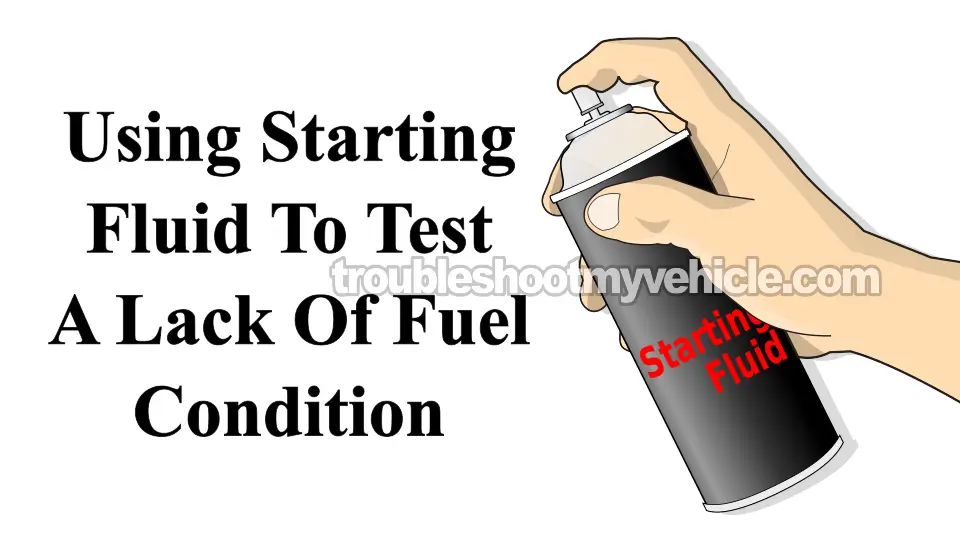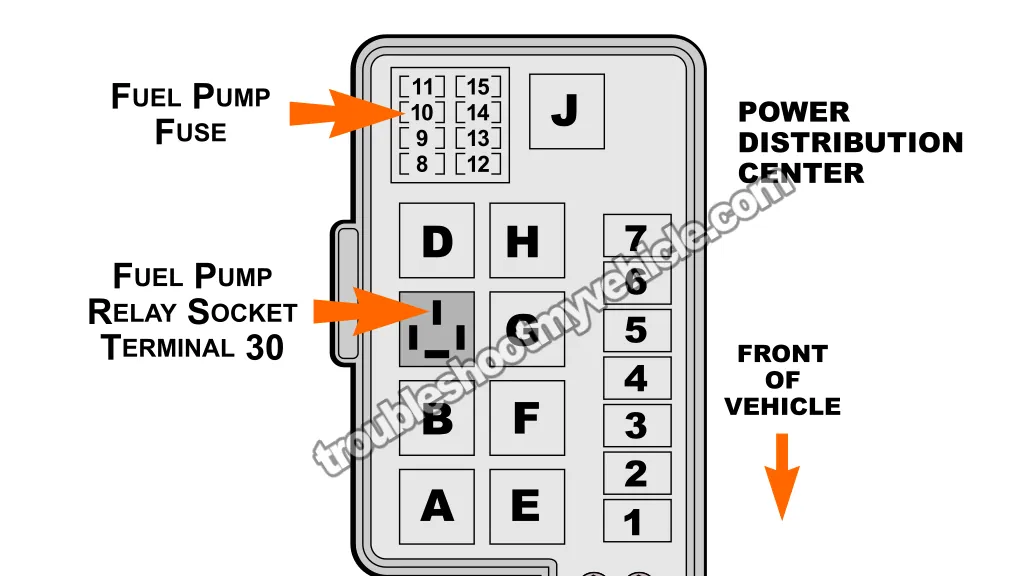
Testing the fuel pump on your 1994–1995 3.3L V6 Chrysler, Dodge, or Plymouth minivan is quick and easy —especially since these vans have a Schrader valve right on the fuel rail.
That means you can connect a fuel pressure gauge directly, without any special adapters or fittings.
I'll walk you through each step, to get to the bottom of an engine no-start problem or engine performance issues that might be caused by a bad or failing fuel pump.
Contents of this tutorial:
- Symptoms Of A Bad Fuel Pump.
- Where To Buy A Fuel Pressure Test Gauge.
- Fuel Pressure Specifications.
- TEST 1: Checking Fuel Pressure With A Fuel Pressure Gauge.
- TEST 2: Using Starting Fluid To Diagnose A No-Start Condition.
- Checking The Fuel Pump Fuse.
- More 3.3L V6 Chrysler, Dodge, And Plymouth Minivan Tutorials.
APPLIES TO: This tutorial applies to the following vehicles:
- 3.3L V6 Chrysler Town & Country: 2001, 2002, 2003, 2004, 2005, 2006, 2007.
- 3.3L V6 Chrysler Voyager: 2000, 2001, 2002, 2003.
- 3.3L V6 Dodge Caravan: 2001, 2002, 2003, 2004, 2005, 2006, 2007.
- 3.3L V6 Dodge Grand Caravan: 2001, 2002, 2003, 2004, 2005, 2006, 2007.
FUEL PUMP TEST TUTORIALS:
- How To Test The Fuel Pump (1992-1993 3.3L V6 Chrysler, Dodge, And Plymouth Minivan).
- How To Test The Fuel Pump (1996-1999 3.3L V6 Chrysler, Dodge, And Plymouth Minivan).
- How To Test The Fuel Pump (2000 3.3L V6 Chrysler, Dodge, And Plymouth Minivan).
- How To Test The Fuel Pump (2001-2007 3.3L V6 Chrysler And Dodge Minivan).
Symptoms Of A Bad Fuel Pump
Your fuel pump's job is simple but critical –it delivers fuel from the tank to the engine at the right pressure. When it fails, it'll do so in one of two ways:
- Complete failure: Your engine won't start at all. You're getting no fuel delivery when you turn the key.
- Partial failure: Your engine starts but stalls or lacks power. The pump still works but can't deliver enough fuel for proper operation, especially under load.
Under load – This refers to any condition where your engine demands more fuel, such as:
- Accelerating from a stop.
- Climbing hills.
- Carrying heavy loads.
- Running the AC.
Other telltale signs of a failing fuel pump are:
- Rough idle: Your engine shakes or runs unevenly at stop lights.
- Long cranking: You're waiting too long for the engine to start.
- Sluggish acceleration: The van feels lazy when you step on the gas.
- Backfiring: You hear popping from the intake during acceleration.
- Check Engine Light: Code 51: System Too Lean appears, telling you the fuel mixture is too lean.
Where To Buy A Fuel Pressure Test Gauge
All of the fuel pump pressure test kits I'm recommending below have the fitting that will connect to your Dodge's Schrader valve:
Disclosure: As an Amazon Associate, I earn from qualifying purchases. If my tutorials help you, using these links is an easy way to support the site at no extra cost to you. Thank you!
Fuel Pressure Specifications
| 1994-1995 3.3L V6 Fuel Pressure Spec | ||
|---|---|---|
| Year | KOEO | KOER |
| 1994-1995 | 48 PSI | Not Given |
- KOEO = Key On Engine Off.
- KOER = Key On Engine Running.
TEST 1: Checking Fuel Pressure With A Fuel Pressure Gauge
The factory manual wants us to use a scan tool to activate the pump with KOEO (Key On Engine Off), and if you have one, well, that's awesome.
If you don't have one, no worries, we'll bypass the fuel pump relay -it's just as effective and pretty much does the same thing the scan tool will do, which is activate the fuel pump with the Key On and Engine Off (KOEO).
Here's the best part: this bypass method takes seconds to set up, and I'll walk you through every step.
Just make sure your jumper wire isn't thicker than the relay's male terminals - you don't want to damage the fuse box connectors.
IMPORTANT: Use an appropriately sized jumper wire (no thicker than the relay pins) to prevent damage to your fuse box terminals.
These are the test steps:
- 1
Place a shop towel under the Schrader valve and its surrounding area.
This catches any fuel that may leak during the next step. - 2
Connect your fuel pressure gauge to the Schrader valve on the fuel injector rail.
- 3
Locate the fuel pump relay and remove it from the underhood fuse/relay box.
- 4
Jumper female terminals 30 and 87 of the relay socket using a jumper wire.
This bypasses the relay and powers the fuel pump directly. Only jumper these two —don't connect anything else. - 6
The fuel pressure gauge should register a steady 48 PSI.
Alright, let's find out what it all means:
CASE 1: Your gauge shows the correct fuel pressure spec. This confirms your fuel pump is working perfectly.
If your engine still won't start, you're dealing with a different issue - the fuel system isn't your problem.
If your engine starts but has a performance issue, the fuel system isn't causing it, you'll need to continue troubleshooting the issue.
CASE 2: Your pressure reading is significantly below 48 PSI. You've got a weak fuel pump that's on its way out. Replace the fuel pump.
CASE 3: Your gauge shows 0 PSI. This generally means your fuel pump has completely failed.
You still need to make sure that terminal 30 (of the relay socket) has 12 Volts. Go to: Checking The Fuel Pump Fuse.
TEST 2: Using Starting Fluid To Diagnose A No-Start Condition

This test is one of the quickest and easiest ways to figure out if your no-start issue is fuel-related.
It doesn't require any tools besides a can of starting fluid and a bit of common sense —and it can save you a lot of time chasing the wrong problem.
Here's what you're looking for: if the engine fires up and runs for a couple seconds after spraying starting fluid into the throttle body, you're dealing with a fuel delivery issue. The engine has spark and compression —it just isn't getting fuel.
But if the engine doesn't respond at all —no sputter, no pop, nothing —then you're not dealing with a fuel problem. In that case, it's time to check for compression issues, etc.
IMPORTANT: The accuracy of this test depends on all six spark plug wires firing spark. So before you reach for the carb cleaner or starting fluid, confirm that all six cylinders are getting spark.
Let's get testing:
- 1
Disconnect the intake air duct from the throttle body. Just loosen the clamp and lift the hose off —no need to remove the whole duct. We'll reconnect it in the next step.
- 2
Spray a 1–2 second burst of starting fluid or carb cleaner directly into the throttle body bore. Aim straight down into the bore for best results. Don't overdo it —a short blast is all you need.
- 3
Slip the air duct back onto the throttle body right away. You don't need to tighten the clamp —just make sure it's seated well enough for the engine to pull in air properly.
- 4
Have your assistant crank the engine. As soon as the air duct is back in place, give the signal to crank. You're listening and watching for what the engine does next.
- 5
Watch the engine's behavior. If it starts up and runs for a second or two, then dies, that's a strong sign the engine has spark and compression, but fuel isn't making it to the cylinders.
- 6
If the engine doesn't react at all —just cranks— you're not dealing with a fuel problem. That means no spark, no compression, or both. It's time to shift your focus to ignition or mechanical issues.
Here's what's going on:
CASE 1: Engine starts, then dies. This tells you the engine has spark and compression —it came to life with the help of starting fluid. That means the issue is in the fuel system, specifically in fuel delivery. Most likely, the fuel pump isn't sending enough fuel (or any at all). Your next move is Test 1: Checking Fuel Pressure With A Fuel Pressure Gauge.
CASE 2: Engine just cranks, no start. If the engine doesn't react at all —no sputter, no pop, just cranking— then you're not dealing with a fuel issue. The problem is likely with ignition or compression. You'll need to run a spark test or check mechanical condition before moving forward.
Checking The Fuel Pump Fuse

0 PSI on your fuel pressure gauge generally means the pump itself is done —but we still need to make sure it's getting power. One of the first things I check is whether terminal 30 at the fuel pump relay socket has battery voltage.
Terminal 30 is supposed to have 12 Volts all the time —key on, key off, it doesn't matter. That voltage comes directly from fuse #10 (15 amp) located in the Power Distribution Center under the hood.
Step one: Use a test light or multimeter to check for voltage at terminal 30. No voltage? Pull fuse #10 and inspect it. If it's blown, replace it and run the fuel pressure test again.
What if the fuse is blown? In my experience, a blown fuel pump fuse is often a red flag. It usually means the pump is on its way out. Even if it still runs, increased internal resistance causes it to draw more current —and eventually that overload takes out the fuse. That's basic electrical law at work: more resistance = more amp draw.
If you replace the fuse and it pops again, don't keep throwing fuses at it. That pump's cooked. Time to drop the tank and replace it.
Now, if the fuse is good, terminal 30 shows between 10 and 12 Volts, and your fuel pressure gauge reads 0 PSI: the fuel pump is bad. It's getting power, but not delivering fuel.
More 3.3L V6 Chrysler, Dodge, And Plymouth Minivan Tutorials
You can find a complete list of 3.3L V6 Chrysler, Dodge, and Plymouth minivan tutorials in this index:
Here's a small sample of the tutorials you'll find in the index:
- P0171 Diagnostics (1996-2010 3.3L V6 Chrysler, Dodge, And Plymouth Minivan).
- P0420 Diagnostics -Catalytic Converter Tests (1996-2010 3.3L V6 Chrysler, Dodge And Plymouth Minivan).
- How To Check For Vacuum Leaks: Carb Cleaner Spray (1991-2010 3.9L V6 Chrysler, Dodge, And Plymouth Minivan).
- How To Test For A Blown Head Gasket (1991-2010 3.3L V6 Chrysler, Dodge, And Plymouth Minivan).

If this info saved the day, buy me a beer!





